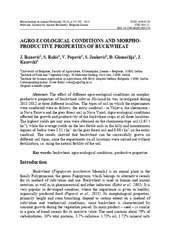Приказ основних података о документу
Agro-ecological conditions and morpho-productive properties of buckwheat
Agroekološki uslovi gajenja i morfološko-produktivna svojstva heljde
| dc.creator | Ikanović, Jela | |
| dc.creator | Rakić, Sveto | |
| dc.creator | Popović, Vera | |
| dc.creator | Janković, Snežana | |
| dc.creator | Glamočlija, Đorđe | |
| dc.creator | Kuzevski, Janja | |
| dc.date.accessioned | 2021-04-26T19:05:24Z | |
| dc.date.available | 2021-04-26T19:05:24Z | |
| dc.date.issued | 2013 | |
| dc.identifier.issn | 1450-9156 | |
| dc.identifier.uri | http://fiver.ifvcns.rs/handle/123456789/1239 | |
| dc.description.abstract | The effect of different agro-ecological conditions on morphoproductive properties of buckwheat cultivar Novosadska was investigated during 2011-2012 at three different localities. The types of soil on which the experiments were conducted were as follows: the eutric cambisol - in Valjevo, the chernozem - in Nova Pazova and the grey forest soil in Nova Varoš. Agro-ecological conditions affected the growth and productivity of the buckwheat crops at all three localities. The highest yields per unit area were obtained on the chernozem-type soil (1.65 t ha-1), while the average yields on the less fertile soils in the hilly and mountainous regions of Serbia were 1.31 t ha-1 on the grey forest soil and 0.80 t ha-1 on the eutric cambisol. The results showed that buckwheat can be successfully grown on different soil types, since the experiments on all locations were carried out without fertilization, i.e. using the natural fertility of the soil. | en |
| dc.description.abstract | Ispitivan je uticaj različitih agroekoloških uslova na morfološkoproduktivne osobine heljde sorte Novosadska u periodu od 2011-2012. na tri različita lokaliteta. Tipovi zemljišta na kome su postavljeni ogledi su: gajnjača - lokalitet Valjevo, černozem - lokalitet Nova Pazova i sivo šumsko zemljište na lokalitetu u Novoj Varoši. Agroekološki uslovi na sva tri posmatrana lokaliteta uticali su na rast i produktivnost heljde. Najveći prinosi zrna heljde po jedinici površine dobijeni su na zemljištu tipa černozem (1,65 t ha-1), dok na zemljištima manje prirodne plodnosti brdsko-planinskog područja Srbije, prosečan prinos bio je 1,31 t ha-1 na sivom šumskom zemljištu, a na gajnjači 0,80 t ha-1. Dobijeni rezultati su pokazali da se heljda može uspešno gajiti na našim zemljištima, budući da su ogledi na svim ispitivanim lokalitetima izvedeni bez prihrane tj. na prirodnoj plodnosti zemljišta. | sr |
| dc.publisher | Institut za stočarstvo, Beograd | |
| dc.relation | info:eu-repo/grantAgreement/MESTD/Technological Development (TD or TR)/31078/RS// | |
| dc.rights | openAccess | |
| dc.rights.uri | https://creativecommons.org/licenses/by/4.0/ | |
| dc.source | Biotechnology in Animal Husbandry | |
| dc.subject | buckwheat | en |
| dc.subject | agro-ecological conditions | en |
| dc.subject | productive properties | en |
| dc.title | Agro-ecological conditions and morpho-productive properties of buckwheat | en |
| dc.title | Agroekološki uslovi gajenja i morfološko-produktivna svojstva heljde | sr |
| dc.type | article | |
| dc.rights.license | BY | |
| dc.citation.epage | 562 | |
| dc.citation.issue | 3 | |
| dc.citation.other | 29(3): 555-562 | |
| dc.citation.rank | M51 | |
| dc.citation.spage | 555 | |
| dc.citation.volume | 29 | |
| dc.identifier.doi | 10.2298/BAH1303555I | |
| dc.identifier.fulltext | http://fiver.ifvcns.rs/bitstream/id/185/1236.pdf | |
| dc.type.version | publishedVersion |


